“Perderò le classifiche di Google se sposto il mio blog?”. È la domanda numero uno che sentiamo ogni volta che chi siamo sta pensando di passare da Blogger a WordPress.
Lo capiamo, ma dopo aver aiutato innumerevoli blogger a compiere questa transizione, possiamo dirvi con sicurezza che è assolutamente possibile passare da Blogger a WordPress senza sacrificare il vostro posizionamento su Google.
Nel corso degli anni, abbiamo perfezionato il processo di migrazione per proteggere la vostra SEO mentre passate a una piattaforma di blog più potente. Attraverso prove ed errori, abbiamo scoperto esattamente cosa fare (e cosa evitare!) per proteggere il posto guadagnato con fatica nei risultati della ricerca di Google.
In questa guida vi illustreremo il nostro metodo collaudato per passare da Blogger a WordPress. Imparerete le stesse tecniche che abbiamo usato per aiutare innumerevoli blogger come voi a migliorare i loro siti senza sacrificare la loro visibilità nei motori di ricerca.
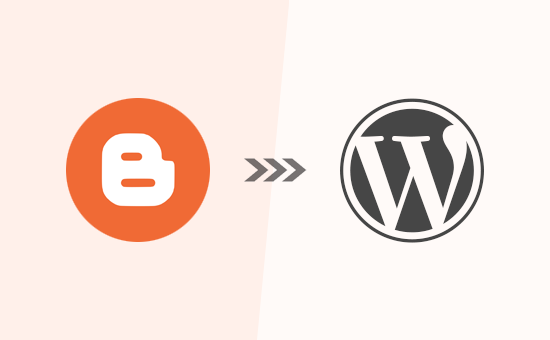
Perché passare da Blogger a WordPress?
Attualmente state usando Blogger, una popolare piattaforma di blog creata da Google che permette a chiunque di aprire un blog gratuito con il proprio account Google.
È un ottimo punto di partenza per molti, ma molti principianti si rendono subito conto che il loro blog gratuito su Blogger può sembrare un po’ limitato. Potreste ritrovarvi a desiderare di poter fare di più.
È qui che entra in gioco WordPress. A differenza di Blogger, WordPress.org vi dà il controllo completo del vostro sito web. Inoltre, vi permette di aggiungere le caratteristiche necessarie per far crescere il vostro blog e guadagnare online. E quando si tratta di farsi notare su Google, WordPress.org vi permette di effettuare tutte le modifiche SEO importanti per migliorare le vostre classifiche.
🌟 Volete maggiori informazioni? Abbiamo messo insieme un confronto dettagliato tra WordPress e Blogger, in modo che possiate vedere tutte le differenze.
Secondo le nostre statistiche di ricerca, WordPress è la piattaforma per siti web più diffusa al mondo e alimenta quasi il 43% di tutti i siti web.
Ciò significa che quando scegliete WordPress, vi unite a milioni di altri siti web di successo. Scegliete una piattaforma che gode della fiducia di moltissime persone e che è perfetta per mostrare i vostri contenuti.
Detto questo, esistono due tipi di software WordPress, per cui importa scegliere quello giusto.
Il primo è WordPress.com, che è un builder per siti web ospitati. Con WordPress.com, non è necessario trovare un piano di hosting e installare il software da soli. Potete invece scegliere un piano gratuito o acquistare uno dei piani a pagamento disponibili e Automattic ospiterà il vostro sito web per voi.
Poi c’è WordPress.org, noto anche come WordPress ospitato all’esterno. Consigliamo sempre di utilizzare WordPress.org perché, a differenza di WordPress.com, non è necessario pagare un piano costoso per poter installare i plugin (considerateli come degli add-on per il vostro nuovo sito web WordPress!).
Detto questo, vediamo come passare correttamente da Blogger a WordPress preservando le classifiche di ricerca su Google e il traffico del sito web.
Ecco tutti i passaggi che andremo a coprire per rendere il passaggio da Blogger a WordPress agevole e orientato alla SEO:
- Step 1. Sign up for WordPress Hosting
- Step 2. Export Your Blogger Blog
- Step 3. Import Blogger to WordPress
- Step 4. Setting Up Permalinks
- Step 5. Set Up Redirects From Blogger to WordPress
- Step 6. Moving Other Content From Blogger to WordPress
- Step 7. Things to Do After Migrating From Blogger to WordPress
- Video Tutorial
Pronti? Iniziamo.
Fase 1: Registrazione per l’hosting WordPress
Per iniziare a utilizzare WordPress, è necessario disporre di un nome di dominio e di un hosting web.
Per un rapido promemoria, il nome di dominio è l’indirizzo del vostro sito web che le persone digitano per raggiungere il vostro blog, mentre l’hosting web è il luogo in cui vengono memorizzati i file del vostro sito. Entrambi sono indispensabili per creare qualsiasi tipo di blog o sito web.
Detto questo, vi consigliamo di utilizzare Bluehost. Si tratta di una delle più grandi società di hosting al mondo e di un partner di hosting WordPress ufficialmente raccomandato.
Poiché WPBeginner è il più grande sito di risorse per WordPress, ha accettato di offrire ai nostri lettori un dominio gratuito e uno sconto del 60% sull’host. In pratica, potete iniziare a lavorare per soli 1,99 dollari al mese.
Se preferite un’alternativa a Bluehost, vi consigliamo di utilizzare SiteGround o Hostinger, perché sono entrambe soluzioni eccellenti (in effetti, noi utilizziamo SiteGround per ospitare WPBeginner!).
Una volta sottoscritto il piano di hosting WordPress e impostato il dominio, si può procedere alla fase di installazione di WordPress.
Se vi iscrivete a Bluehost utilizzando il nostro link qui sopra, vi installerà automaticamente WordPress.
Se avete utilizzato un altro provider di hosting WordPress, allora dovete installare WordPress seguendo la nostra guida definitiva su come installare WordPress.
Dopo aver installato WordPress, è il momento di spostare i contenuti da Blogger a WordPress.
🧑💻 Vi abbiamo sentito forte e cancellato! Poiché molti di voi ce lo hanno chiesto, siamo entusiasti di annunciare che ora offriamo un servizio di migrazione da Blogger a WordPress completamente gratuito come parte della configurazione gratuita del nostro blog WordPress! Proprio così: uno dei membri del nostro team di esperti si occuperà di tutto per voi, gratuitamente. Potrete letteralmente passare da Blogger al potente mondo di WordPress senza alcun problema o rischio.
Il nostro servizio gratuito di migrazione da Blogger è perfetto per i blog più piccoli, con meno di 1000 pubblicazioni. Se avete un sito Blogger più grande, non preoccupatevi! Possiamo comunque aiutarvi con la migrazione, ma si tratta di un servizio a pagamento.
Passo 1: Esportare il blog di Blogger
La prima cosa da fare è esportare i contenuti del blog Blogger. Per farlo, visitate il sito web di Blogger e accedete al cruscotto del vostro account.
Successivamente, andare alla pagina delle impostazioni. Scorrere fino alla sezione “Gestione del blog” e fare clic sul pulsante “Backup dei contenuti”.
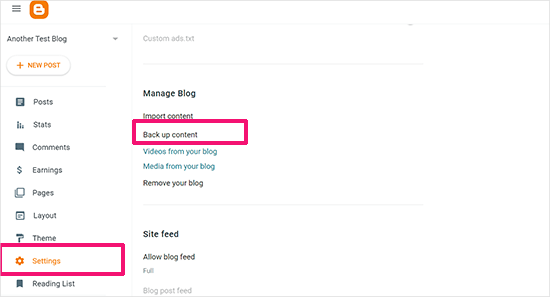
Verrà visualizzata una finestra a comparsa che mostra cosa è esattamente incluso nel backup di Blogger.
Per continuare è necessario fare clic sul pulsante “Download”.
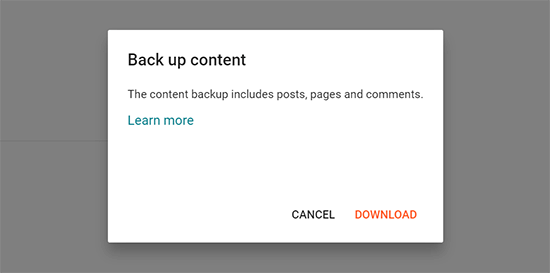
Il contenuto del vostro blog Blogger verrà scaricato sul vostro computer in un file XML.
Una volta completato il download, è il momento di importare i contenuti di Blogger nel sito WordPress.
Passo 2: Importare Blogger in WordPress
Per iniziare a importare il vostro sito Blogger in WordPress, accedete all’area di amministrazione di WordPress e visitate Strumenti ” Importazione.
Nella pagina di importazione, fare clic sul link “Installa ora” sotto Blogger.
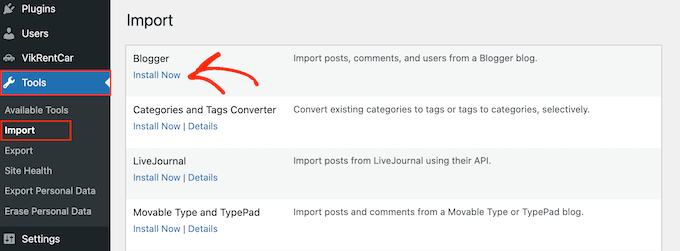
WordPress scaricherà e installerà il plugin Blogger Importer per voi.
Una volta terminata l’installazione, è necessario fare clic sul link “Run Importer” per continuare.
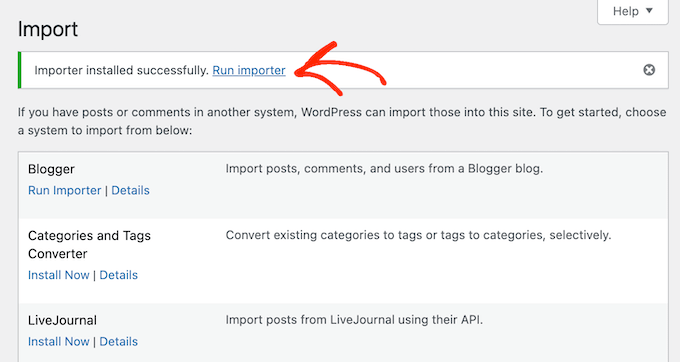
WordPress vi chiederà di caricare il file XML nella schermata Importa Blogger. Si tratta del file scaricato al punto 1.
È sufficiente fare clic sul pulsante “Scegli file” e caricare il file XML scaricato in precedenza.
Quindi, fare clic sul pulsante “Carica file e importa” per continuare.
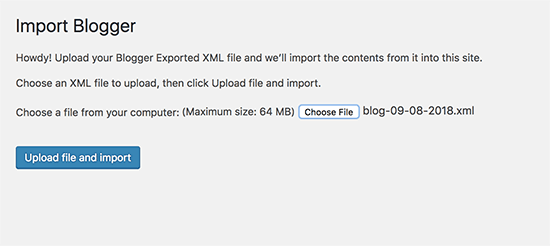
WordPress caricherà ora il file di importazione. Se il file di importazione è troppo grande, potrebbe essere visualizzato un messaggio di errore.
In questo caso, è necessario aumentare il limite massimo di caricamento dei file. Se il file è di piccole dimensioni, non si noterà alcun errore.
Successivamente, vi verrà chiesto di assegnare i post a un autore. Se avete più autori sul vostro blog Blogger, potete creare un nuovo account utente per ogni autore. Potete anche assegnare questi post ad autori esistenti sul vostro sito WordPress.
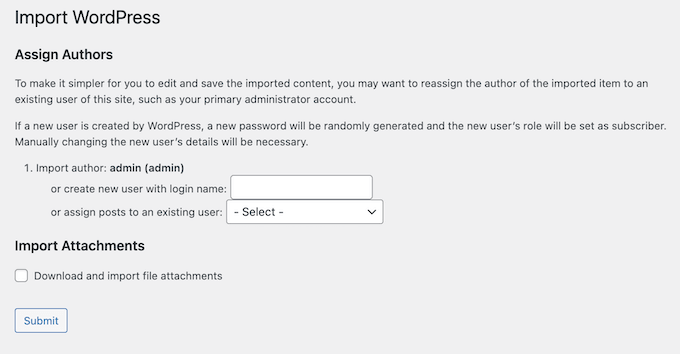
Dopo aver effettuato la selezione, fare clic sul pulsante “Invia” per continuare.
WordPress importerà tutti i contenuti dal file di esportazione di Blogger al vostro sito WordPress. È possibile visualizzare il contenuto visitando la pagina Post ” Tutti i post.
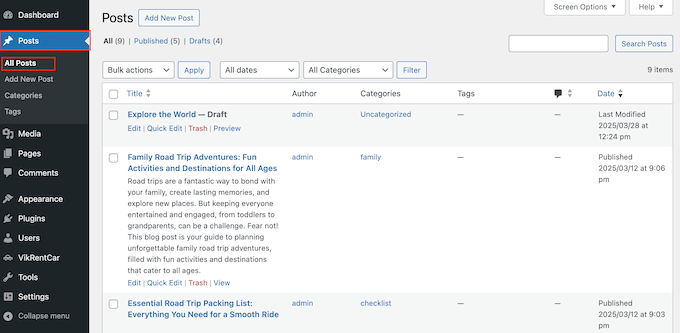
Passo 3: Impostazione dei permalink
Permalinks è il termine usato per la struttura degli URL delle singole pagine. WordPress è dotato di una funzione che consente di impostare una struttura URL SEO-friendly.
Poiché state importando contenuti da Blogger, è necessario che la struttura degli URL sia il più possibile simile a quella del vecchio sito di Blogger.
Per impostare i permalink, è necessario andare su Impostazioni ” Permalink nella dashboard di WordPress e scegliere l’opzione “Struttura personalizzata”.
Successivamente, è necessario aggiungere il seguente testo nella casella accanto al campo della struttura personalizzata:
1 | /%year%/%monthnum%/%postname%.html |
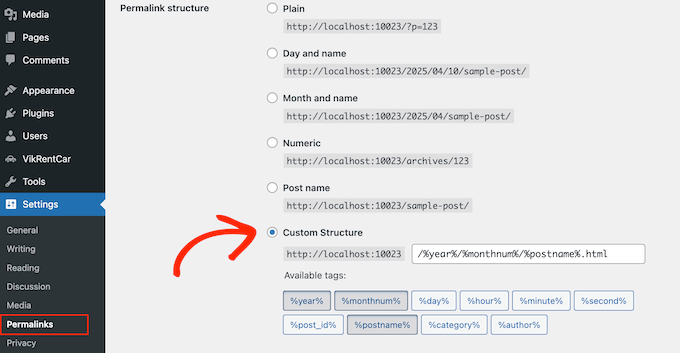
Questa struttura di permalink rende gli URL dei post del blog simili a quelli del vecchio blog di Blogger.
Tuttavia, a volte l’URL del post del blog, noto anche come slug in WordPress, non corrisponde agli slug utilizzati da Blogger.
Per risolvere questo problema, è necessario creare ed eseguire un piccolo frammento di codice.
Si consiglia di aggiungere questo codice PHP utilizzando il plugin WPCode. È il modo più sicuro per aggiungere codice personalizzato al vostro sito WordPress. Per maggiori dettagli, consultate la nostra guida su come copiare e incollare snippet di codice in WordPress.
1 2 3 4 5 6 7 8 9 10 11 12 13 14 | add_action( 'init', 'wpb_update_slug' );function wpb_update_slug() {global $wpdb;$result = $wpdb->get_results("SELECT post_id, meta_value FROM $wpdb->postmeta WHERE meta_key = 'blogger_permalink' ");$wpdb->print_error();foreach ($result as $row){$slug = explode("/",$row->meta_value);$slug = explode(".",$slug[3]);$wpdb->query("UPDATE $wpdb->posts SET post_name ='$slug[0]' WHERE ID = '$row->post_id' ");}echo "DONE";} |
Dopo aver salvato il codice, è sufficiente visitare una pagina qualsiasi del vostro sito WordPress per triggerare lo script. Dopo l’esecuzione dello script, non dimenticate di disabilitarlo o eliminarlo dalla libreria WPCode, perché deve essere eseguito solo una volta.
Passo 4: Impostare i reindirizzamenti da Blogger a WordPress
Il passo più importante nel trasferimento di un sito web è quello di impostare una corretta reindirizzazione, in modo da non perdere il traffico esistente o le classifiche SEO. Per maggiori dettagli, potete consultare la nostra lista di controllo definitiva per la migrazione SEO di WordPress.
⚠️ Se il vostro blog Blogger ha un dominio personalizzato invece di blogspot.com, potrebbe essere necessario puntare i nameserver del dominio al vostro fornitore di hosting. Per istruzioni, seguite il nostro tutorial su come passare un blog Blogger con dominio personalizzato a WordPress.
La parte cruciale del reindirizzamento consiste nel garantire che gli utenti arrivino sulla stessa pagina del nuovo dominio a cui stavano cercando di accedere sul vecchio sito.
Allo stesso tempo, dovete anche assicurarvi che i motori di ricerca capiscano che il vostro sito web è stato spostato in questa nuova posizione.
Per farlo, è necessario installare e attivare il plugin Blogger to WordPress Redirection. Per maggiori dettagli, consultate la nostra guida passo passo su come installare un plugin per WordPress.
Dopo l’attivazione, è necessario visitare la pagina Strumenti ” Reindirizzamento da Blogger a WordPress e fare clic sul pulsante “Avvia configurazione”.
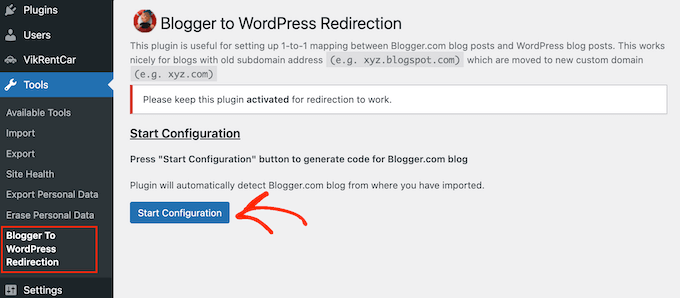
Il plugin rileverà ora l’URL del vostro blog Blogger e vi mostrerà l’opzione per ottenere un codice di reindirizzamento. Fare clic sul pulsante “Ottieni codice” accanto all’URL di Blogger.
A questo punto verrà generato uno snippet di codice necessario per reindirizzare correttamente gli utenti dal vecchio blog Blogger al nuovo sito WordPress.
Successivamente, è necessario accedere alla dashboard di Blogger e andare alla pagina “Temi”. Fate clic sulla freccia a discesa del pulsante “Personalizza” accanto al vostro tema e selezionate l’opzione “Modifica HTML”.
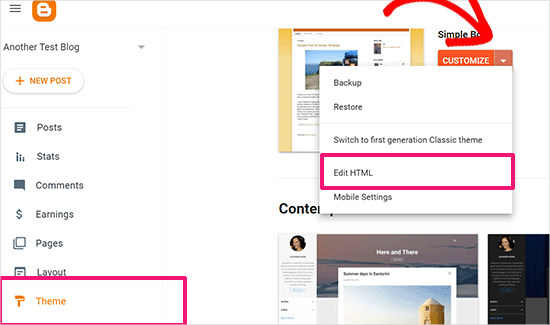
Blogger visualizzerà ora il codice HTML personalizzato per il modello del tema. Se sono state apportate delle personalizzazioni al tema di Blogger, è consigliabile copiare il codice e salvarlo sul computer come backup.
In caso contrario, è possibile procedere all’eliminazione di tutto. Dopodiché, copiate il codice visualizzato dal plugin sul vostro sito WordPress e incollatelo nell’editor del tema di Blogger.
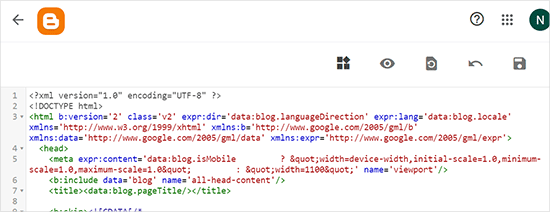
Non dimenticate di fare clic sul pulsante “Salva tema” per memorizzare le modifiche.
Successivamente, dobbiamo impostare i reindirizzamenti per gli utenti mobili.
È necessario tornare alla pagina dei temi nella dashboard del blog Blogger. Questa volta dovete fare clic sul pulsante dell’ingranaggio sotto l’anteprima mobile del vostro blog.
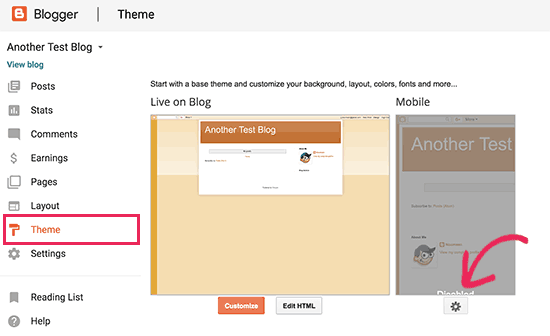
Si aprirà un popup in cui si dovrà selezionare l’opzione “No. Mostra il tema desktop sui dispositivi mobili”.
Quindi, fare clic sul pulsante “Salva”.
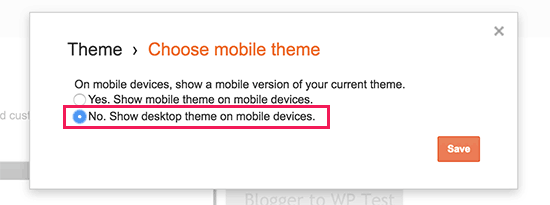
È tutto, il vostro blog Blogger ora reindirizzerà tutti i visitatori del blog al vostro nuovo blog WordPress.
In alternativa, è possibile utilizzare All in One SEO (AIOSEO) per reindirizzare post e pagine da Blogger a WordPress. Il plugin offre una potente funzione di gestione dei reindirizzamenti che consente di impostare reindirizzamenti completi al nuovo sito.

Inoltre, è possibile attivare il monitoraggio degli errori 404 e individuare eventuali link non funzionanti nel passaggio del sito a WordPress. In questo modo migliorerete l’esperienza dell’utente e non perderete il posizionamento delle parole chiave.
Utilizziamo AIOSEO per gestire tutte le pagine e le pubblicazioni di WPBeginner – e onestamente? I risultati ci hanno entusiasmato. Ecco perché lo consigliamo a tutti voi.
Per approfondire le nostre esperienze, consultate la nostra recensione dettagliata di AIOSEO.
Passo 5: Spostare altri contenuti da Blogger a WordPress
In questa fase, sposteremo i contenuti rimanenti dal vecchio blog su Blogger al nuovo blog WordPress. Questa operazione potrebbe richiedere un po’ di lavoro manuale, a seconda delle impostazioni/contenuti del vostro blog.
1. Spostare le pagine da Blogger a WordPress
Lo strumento di importazione di Blogger di WordPress importa solo i post di Blogger e ignora le pagine.
Per trasferire le vostre pagine in WordPress, dovrete modificare ogni pagina del vostro blog Blogger, copiarne il contenuto e poi creare manualmente una pagina in WordPress.
Per saperne di più sulle pagine, consultate il nostro articolo sulla differenza tra post e pagine in WordPress.
Ora vi imbatterete in un altro problema. Le pagine di Blogger hanno URL di questo tipo:
http://example.blogspot.com/p/about-us.html
L’URL della pagina di WordPress avrà il seguente aspetto:
http://example.com/about-us
Per risolvere questo problema, è necessario utilizzare il plugin All in One SEO (AIOSEO). Per le istruzioni, consultare la nostra guida per principianti sulla creazione di redirect in WordPress.
2. I widget
Come Blogger, anche alcuni temi di WordPress utilizzano i widget per aggiungere contenuti alla barra laterale del blog.
Per aggiungere i widget, è necessario visitare la pagina Aspetto ” Widget nella dashboard di WordPress e trascinare semplicemente i widget nelle barre laterali. Per istruzioni dettagliate, consultate la nostra guida su come aggiungere e utilizzare i widget in WordPress.
Se state cercando un widget specifico che non è presente in WordPress per impostazione predefinita, probabilmente avete bisogno di un plugin per WordPress. Potete cercare nella categoria dei migliori plugin per WordPress di WPBeginner per trovare la funzionalità che desiderate.
3. Feed RSS
I motori di ricerca e gli utenti che si iscrivono ai post del vostro blog tramite feed RSS saranno ancora in grado di trovare il vostro blog. Tuttavia, non riceveranno alcun nuovo contenuto.
Per risolvere il problema, visitate la pagina delle impostazioni del vostro account Blogger. Scorrete quindi la sezione “Feed del sito” e fate clic su “URL di reindirizzamento del feed del post”.
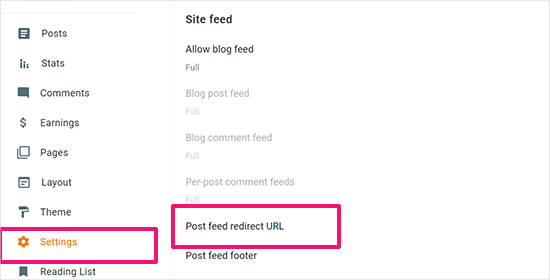
Si aprirà una finestra a comparsa in cui dovrete aggiungere l’URL del feed RSS del vostro sito web WordPress.
L’URL del feed di WordPress avrà il seguente aspetto:
http://example.com/feed
Non dimenticate di sostituire example.com con il vostro nome di dominio.
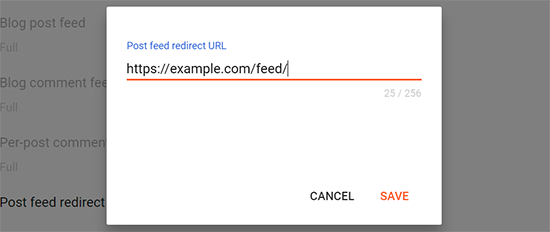
Fare clic sul pulsante “Salva” per aggiungere l’URL e salvare le impostazioni.
Passo 6. Cose da fare dopo la migrazione da Blogger a WordPress
Ora che avete trasferito con successo il vostro blog da Blogger a WordPress, vediamo cos’altro potete fare per migliorare il vostro blog.
Abbiamo creato una lista di controllo delle cose più importanti da fare dopo l’installazione di WordPress.
WordPress è abbastanza facile da usare. Tuttavia, di tanto in tanto scoprirete cose nuove per le quali potreste aver bisogno di aiuto. È qui che entra in gioco WPBeginner.
WPBeginner è il più grande sito di risorse gratuite per WordPress al mondo. Pubblichiamo regolarmente tutorial e guide scritte appositamente per blogger e piccole imprese.
Ecco alcune delle risorse utili che troverete su WPBeginner (tutte gratuite):
- WPBeginner Blog – Il luogo centrale per tutti i nostri tutorial e guide su WordPress.
- Dizionario WPBeginner – Il nostro glossario di WordPress è il posto migliore per familiarizzare con il gergo di WordPress.
- Video WPBeginner – I nuovi utenti di WordPress possono iniziare con questi video passo-passo per padroneggiare WordPress.
- WPBeginner su YouTube – Avete bisogno di altre istruzioni video? Iscrivetevi al nostro canale YouTube con più di 291.000 iscritti e oltre 50 milioni di visualizzazioni.
- WPBeginner Blueprint – Scopri i plugin, gli strumenti e i servizi che utilizziamo su WPBeginner.
- WPBeginner Deals – Sconti esclusivi su prodotti e servizi WordPress per gli utenti WPBeginner.
Video tutorial
Speriamo che questo articolo vi abbia aiutato a passare da Blogger a WordPress senza influenzare le vostre posizioni di ricerca su Google. Potreste anche voler consultare la nostra guida su quale piano WordPress dovreste utilizzare o i più comuni miti di WordPress sfatati.
Se questo articolo vi è piaciuto, iscrivetevi al nostro canale YouTube per le esercitazioni video su WordPress. Potete trovarci anche su Twitter e Facebook.





Mike Oplinger
Ok I’m on step #3 and I’m to the part where I select WPbeginner on my blogger page but I don’t have anywhere to select this, all I have is an option to select the order the page shows up in which is currently 0.
Shell
I had the same issue. The problem was I had put my wpb-blogger.php file into the /public_html/wp-content/themes/ folder instead of in the folder of the specific theme I was currently using. Perhaps the tutorial could state this a little more clearly?
Rebecca
Thank you for this! That was exactly what I was stuck on as well and that worked beautifully!!!
Karen
THANK YOU! I was having the same problem and your suggestion fixed it!
Lori Ketcherside
THANK YOU!!!
mansoor1223
Hi, I just did the same as what is written here, but when i searched google for a post and clicked that Link i am seeing a 404 Not Found Page
Ronamae
How to solve this?
Oops! That page can’t be found.
It looks like nothing was found at this location. Maybe try one of the links below or a search?
Alonso Valdés Morales
I was reading other blogs about this topic, and I got a question. Do I need a custom domain on Blogger.com to make this migration?
Thanks!
WPBeginner Staff
Seems like WordPress is unable to connect with your blogger account. Please check your blogger username and password and try again.
dani
Assalam-u-Alaikum brother Syed Balkhi
When I install blogger importer in wp and then I click Tools>import so I face this error.
Please tell me what happened and how to solve it.
Jazak-Allah and Thanks.
WPBeginner Staff
You can re-run the importer again. It is smart enough not to import posts previously imported successfully.
Awais
I completed all the steps as written. No problem. The one issue I have is that if anyone goes to click on a link from facebook or twitter to read that specific blog article, it takes them to the main WordPress blog page not to that individual blog. Then, they would have to actually search for it by name on the right column. How can this be fixed please? I’ve spent nearly a day trying to figure this out. Thanks.
Shane Carmody
Cheers for this. Almost everything worked great and I didn’t have to do Step 5 as the Blogger importer did it for me. The only gripe I have is that the Blogger importer stalled at the end and it didn’t finish off. Aside from that, redirection works like a charm.
Thanks for the great tutorial.
Melissa
I had to run the importer multiple times, so don’t lose heart!
mariya
i don’t understand I am stuck at the step where i change my blogger template to classic and go into the edit html…i cannot find http://www.example.com in my web address…what am I doing wrong ?? please help ! note i don’t have my own domain name its like
” xyz.blogspot.com”
please help !
jnader
I completed all the steps as written. No problem. The one issue I have is that if anyone goes to click on a link from facebook or twitter to read that specific blog article, it takes them to the main WordPress blog page not to that individual blog. Then, they would have to actually search for it by name on the right column. How can this be fixed please? I’ve spent nearly a day trying to figure this out. Thanks.
Sarah
I have completed the transfer and it all seems great except when I google specific posts it directs me to my new wordpress but the link leads you to one of my wordpress pages, not the individual post. Did I miss a step?
Dok Simon
Am quite confused here .. I have my own paid domain already , how do I export without loosing anything ??
srividhya
This is really helpful. But I am not able to find the permalinks under settings in WP. Where should I change my permalinks?
Thanks
Tiffany Burton
Thank you for a wonderful tutorial. After reading many of the comments and double checking things I still have a question. The redirect links on my blogger site are working great. All my posts have a link now that takes them to my new wordpress site. The problem is when I get there instead of taking me to the matching post my wordpress site says:
“Well this is somewhat embarrassing, isn’t it? It seems we can’t find what you’re looking for. Perhaps searching, or one of the links below, can help.”
Everything imported correctly and the posts are there. What part did I do wrong? I have the blogger page made and uploaded my php file via filezilla without a problem. I even found a plugin to let me exclude pages from my sites navigation bar. This is my first time ever typing code of any kind could that be the problem? I am just wondering what I need to do from here.
Wilson Pina
Another HQ post! Of course, we couldn’t expect Anything else from the good folks @ WP Beginner ))))
Balaji
cleared all my doubts thanks
thanks
Mark
Great article – thanks. Just one issue I’m having is that I have to use custom permalinks in WordPress so they don’t match from blogger:
WP: [domain]/%year%/%postname%/
Blogger: [domain]/%year%/%month%/%postname%.html
Any idea where/how I can change this?
WPBeginner Staff
Please make sure that you have modified the blogger template correctly and that it is redirecting users to the blogger page on your WordPress site.
Also make sure that the blogger page is using the wpb-blogger.php file as its template.
If all of this seems right, then check the URL you are directed to and compare it with the post’s URL on your WordPress site. Report back with more information and we will try to figure this out.
Kristiyan Bogdanov
Ooops. I forgot to make the page. Now its all fine. Works perfectly! Is it safe to hide or delete the page now?
Diana
Thanks for these instructions, I have to admit i have four this a HUGE learning curve. Ive followed all of your steps to the letter, but now am at the end of Step 3. I have created a new page, but don’t get the WP Beginner Blogger option on drop down. Did I miss a step somewhere. any help would be much appreciated.
Aljaž Ribnikar
Thanks for this tutorial. I did all steps above but there is something wrong with redirection. My new wordpress blog is on sub directory of my online shop (shopurl/blog) but if I visit old post on blogger it will redirect me to my root domain (online shop) and not to my wordpress blog post. My old blogger was on sub domain of this same online shop (blog.shopurl).
Guest123
Hi, I had recently started on blogger and now trying to make the switch to wordpress. I am trying to import blogger content to wordpress but having issues. When I am on blogger>setting>blog tools and I click on export blog, and click on the option to “download blog” an error comes up saying “safari could not update this feed because the source file is no longer available”. How do I fix this so that the contents I have on blogger is moved to wordpress? thank you!
Aljaž Ribnikar
Hi! Thanks for your tutorial! Everything worked great, except redirects from blogger post to wordpress post. I have online store on some other platform and separate installation for wordpress blog on subdir of my online store. My blogger blog is on http://www.blog.mywebstoreurl.com. Now I am moving from custom blogger domain to wordpress subdir on my website: http://www.mywebstoreurl.com/blog/. I did all steps above but when I open old blogger post it will redirect me to my website root (www.mywebstoreurl.com) not even to blog (www.mywebstoreurl.com/blog/). If I open old blogger root page it will redirect me OK to http://www.mywebstoreurl.com/blog/. I hope I didn’t complicate it too much:) Any idea?
eL-hAkeeM
I’ve followed your instructions but still can’t get my embed videos back,,
can you tell me how to fix it??
WPBeginner Staff
We will look into it and update the article.
Jason Knoell
Is there any update on this? I realize you’re not my personal support line but I do need to find a fix for this ASAP…
but I do need to find a fix for this ASAP… 
Angelo
Jason, did you find any solution?
Angelo
I have the same problem. Mobile version is still showing. Also when using an old article link it reffers only to the home page of the new wordpress site. Hoping for help.
Jason Knoell
This is fantastic and works like a charm without loading in more plugins. Thank you! However…. When I visit the site on my iphone, it doesn’t redirect me. Is this because it’s a mobile verion of the blogger site? Is there a way to catch that too?
WPBeginner Staff
Adrain you should remove it from your site’s navigation menus or sidebars. The purpose of this page is to redirect users coming from blogger to correct posts in WordPress.
Making a page private will make it inaccessible. This means users coming from blogger will not be redirected.
Adriane
After creating the page labeled “Blogger” and using the WP Beginner theme, what is the purpose of the page and should it be displaying anything? When I click on it I just see a white screen.
WPBeginner Staff
The purpose of this template is to redirect users coming from blogger to correct posts on your WordPress site.
Adriane
Is there something wrong if it leads me to a blank white screen when I click on the blogger tab? Can I make it private or should it remain visible? Thanks!
Lauren
So happy I found this post. I think it’s time to make the switch.
Amber K. Sanders
This article was helpful, but I do have an issue. I want to add a “blog” menu tab that will then allow clients to be on my site and read additional posts. How can I get my posts to show up when I add a new page?
WPBeginner Staff
Seems like redirection is not working, please make sure that you haven’t missed anything.
Cathy
I’m having the same issue, although I’m getting a 403 error. When I test a link from the old blogger site, the address in the bar changes to something like http://www.newblog.com/blogger/?q=http://www.oldblog.blogspot.com/2014/04/old-blog-post-title.html which results in the 403. I’m pretty sure I’ve followed all the steps noted, can you advise? Thanks!
Cathy
I wanted to reply to my earlier post, because I found out what the issue was. The new WordPress blog is hosted on Hostgator, and that particular host has some changes that need to be made in order for this Blogger–>Wordpress technique to function correctly. If you contact tech support there, they can assist with it.
John Potenza
Can you tell me what exactly they did, or do you have no idea? I also have hostgator, would love to know.
Andrea @ Why Roam?
Hi, thank you for this post! The instructions were very easy to follow. Everything has worked perfectly for me. However, once I tested a link from my old blogger site, I received a 404 not found error. I’ve tried several posts and receive the same error. If I do a site search, the old post comes right up. Any advice?
Kristiyan Bogdanov
Same problem here! @wordpressbeginner:disqus, Please help!
Satya
I have a blogger blog having custom domain name. I followed all the steps above..but the issue is still my blogger post redirected to home page(wordpress blog) only..Plz help..
Helen
Sorry – I’ve fixed it. The main issue for other users is finding the right folder to put the php folder in. Not easy and you may have to contact your host support as I did.
anu
I do have another question as well…do you know how I can move my blog followers to wordpress site? is there a plugin?
anu
This is a very helpful post…thank much for sharing…I have a question here,….this will move only the post, comments and the media right? but it does not do anything to move the blog pages to the wordpress….is there a way to move the pages and it’s contents as well?
I still didn’t do the redirection …as I was not sure if I need to do more changes with respect to the pages in wordpress.
Please help.
Mahesh Waghmare
Nice article, Thanks.
Sharron Goodyear
I have followed your instructions up to the point before saving the php file. I went into Edit HTML and deleted the code that was there and replaced it with what you have listed above. I then saved the template.
However now when I try and access the ‘Edit HTML’ I get the following error message:
We’re sorry, but we were unable to complete your request.
When reporting this error to Blogger Support or on the Blogger Help Group, please:
Describe what you were doing when you got this error.
Provide the following error code.
bX-4b250i
This information will help us to track down your specific problem and fix it! We apologise for the inconvenience.
Close
Please could you tell me why this might be as this is causing a major issue for me!!
Many thanks
Sharron
WPBeginner Support
Wait for a while and then try again. Remember that your posts on your blogger site are perfectly safe and you can always go back to Templates and restore your blogger blog.
Admin
marielle altenor
I’m in the process of moving my blogger site to wordpress.org. My question has to do with Google Analytic. Do you have a post that talks about how to go about it? Would I be using the same profile for my new wordpress.org blog or create a new one and start the page view and such from the start?
WPBeginner Support
Marielle, yes we do have a Google Analytics setup guide. You can use the same Google account. However, since this will be a different domain name, you will have to create a new site profile for it.
Admin
Avadhesh
What if i also want to move the domain too.
Tanja Jensen
Hi there! The quality is not good…. But all the images did import into my media library.
The quality is not good…. But all the images did import into my media library.
After I imported my blog, all my images are looking bad
Can I do something that will update all the images in my posts or do I really have to go through every single post manually?
– Tanja
WPBeginner Support
Tanja if you have successfully imported images to your media library, then you probably need to regenerate images.
Admin
Tanja Jensen
Hello again! Well, it did help me with my thumbnails, but my pictures in my posts still look grumsy. I have tried to upload the same picture again directly from the media library, but I really do not want to go through all my 300 posts if I can help it! See example here: Can you see my problem?
Tanja Jensen
Oh…. I can see that the URL of the image is the old IP address from WordPress – I guess it should be custom domain? Can I change that in a quick way?
WPBeginner Support
You can try importing the external images. After that you need to run the regenerate thumbnails script once again.
Tanja Jensen
Hi there
I have a problem with Step 3. I cannot see my .php file unde ‘Template’ when creating the new page titled ‘blogger’. What may I have done wrong?
– Tanja
Tanja Jensen
Uh, I think I fixed it. Just had the place the file in some sub directories = the right place Although a bit hard to figure out since there are many main and sub folders in my FTP client! Hard for a beginner to figure out… – Tanja
Although a bit hard to figure out since there are many main and sub folders in my FTP client! Hard for a beginner to figure out… – Tanja
Adriane
I’m having the same problem. Where do you end up needing to put it?
TIffany Ima
This is a great tutorial, except it doesn’t explain how to add the file to the theme directory, and I am completely lost. I cannot get my post to redirect appropriately.
WPBeginner Support
Tiffany, you need to use an FTP client to upload the file to your theme directory.
Admin
Tanja Jensen
HI there! I am about to move my blogspot blog to WordPress – YAY! But before I do that, I want to make sure about one thing: when I import my blog from blogspot to WordPress, will I then delete it on blogspot or just copy it? I mean, if something goes wrong, I want to be able to go back to my blogspot to continue making posts until I get the WordPress to work. I haven’t seen the ‘inside’ of the WordPress admin panels, so I don’t know how it all looks. I mean, do I have a special section called ‘posts’, where I write post, edit my old ones etc?
I haven’t seen the ‘inside’ of the WordPress admin panels, so I don’t know how it all looks. I mean, do I have a special section called ‘posts’, where I write post, edit my old ones etc?
Another question – when I import my blog, where will WordPress import my blog posts – to a particular page or to specific WordPress posts? And what about my tags/labels or what you call it here… I depend a lot on my division on tags
Thanks for the help! – Tanja
WPBeginner Support
Tanja, this guide does not ask you to delete any posts from your Blogspot site. This method only redirects users coming to your blogger site to your WordPress site. Your blogger posts should remain as they are and if you wish you can always switch back your blogspot template and your blogger site will be live and accessible again.
Admin
Tanja Jensen
Good to know, I was just worried about what was meant by the word ‘import’ – delete or copy I am a beginner (as most others looking at this site), so I just wanted to make sure – that I could still run my blog while I was setting up the WordPress version of it. Thanks for the help!
I am a beginner (as most others looking at this site), so I just wanted to make sure – that I could still run my blog while I was setting up the WordPress version of it. Thanks for the help! 
Bob Jones
I have the same problem that Rachelle, above, has. When I then go to create a page in WordPress, WPBeginner Blogger does not come up as an option in the templates. My only options are “Default Template,” “Contributor Page,” and “Full Width Page.”
Any post I view on Blogger now shows the text of this page, concatenated in a continuous line of text.
Help!
Bob Jones
Salem, Oregon
WPBeginner Support
Bob, it seems like the template file is missing theme, which is causing WordPress not to recognize the template file. Please copy pase the code again.
Admin
Bob Jones
Thank you for your reply to my question. I copied the code in the first block under step 3 into my blogger template. I then copied the code in the second block of step 3 into a wpb-blogger.php file and uploaded that file to the server directory containing the WordPress files. I see that WPBeginner Blogger is the name of that template.
What happens now when I click on a post in a Google search results page listing is that I get sent to the blogger page I created in step 3. I do not get sent to the post that was shown on the results page.
Also, I still do not have WPBeginner Blogger as a choice in the Page Attributes / Template drop-down box.
Getting closer, but still not there.
Bob Jones
Salem, Oregon
David Reber
Did something change in the newer versions of WordPress. I needed to add the Page Theme plugin to allow for a different theme to be used on different pages.
Farhan
Thanks for the great article, I want to move my blogger site to wordpress but want a new perma link structure.
So instead of a date based system i.e. year/month/blog title like 2014/03/tutorialA.html I want to change it to /tutorials/3Dsoftware1/tutorial1.html
Is there a code solution that I can implement in the head of the blogger file or in each post’s html version to target my old blogger posts to my new wp site? Each post will now be listed by its categoryName/post_title.
Perhaps I should create two posts i.e. do the straight forward conversion then apply category based URI with a 301 redirect? I imagine not as there will be an extra duplicate post.
Thanks so much
Asdrubal Romero
I have done all up to the point of setting redirection at wordpress. You say that i have to upload a file but i do not even know how i do that. What is the ftp direction of wordpress and do they have a reserved space for each user?
WPBeginner Support
First make sure that you are on a self hosted WordPress.org site and not WordPress.com blog (see the difference). After that you need to contact your web host to find out your FTP account user name and password. In case you don’t want to use FTP, some web hosts also offer a file manager available on your cPanel dashboard.
Admin
nil
Hey,
I would only like to change the rel=canonical URL from my old blogger blog to my new blog, not redirect everything. Do you know how? That would be great!
Just tried few manuals from the net, nothing works anymore.
Thanks
nil
Rachelle
Hello,
I’ve been able to import my blogger posts (except the very first post, which I still cannot figure out why it didn’t import) to my hosted WordPress account. I was able to get everything to work–including the Blogger redirect–until I reached the step where you have to setup the redirect for WordPress itself so that each individual post on Blogger is redirected to the new location on WordPress. I created the PHP file and pasted in the code exactly as was posted above. I then uploaded the file to the theme folder where the WordPress files are on my account. However, when I then go to create a page in WordPress, WPBeginner Blogger does not come up as an option in the templates. My only options are “Default Template,” “Contributor Page,” and “Full Width Page.”
I’m at a total loss as to where I went wrong. Any ideas on how to correct this issue? I don’t want people clicking on a direct link to one of my Blogger articles to see a “Page Not Found” error.
Thanks!
Glenn
I have the same problem: I uploaded the file and the WP Beginner template does not show as an option. Can someone share a solution?
WPBeginner Support
Please make sure that you have created the template file in /wp-content/themes/your-theme-directory/
Admin
Glenn
I *think* we’re getting close, but it’s still not working. Hmm, do I need to do anything differently if my wp blog has a different title than my blogger blog:
blogger name: autismplusmath.blogspot.com
wp name: autismpluslande.com
THANK YOU for your continued help with this: appreciate the quick reply to my last query!
Emma
I have tried everything on redirect from blogger and I get this error:
Error parsing XML, line 2, column 73: The value of attribute “dir” associated with an element type “html” must not contain the ‘<' character.
can you help please?
WPBeginner Support
Emma, it seems like you are pasting the blogger template code in the wrong location.
Admin
Dino
Hi,
I have a self hosted blog WordPress on Bluehost and I’m trying to migrate contents from my old Blogger blog.
I did the export step from Blogger, but when I’m on my wordpress dashboard, I do tools>import, then a completely white page appears.
What can I do?
Thanks.